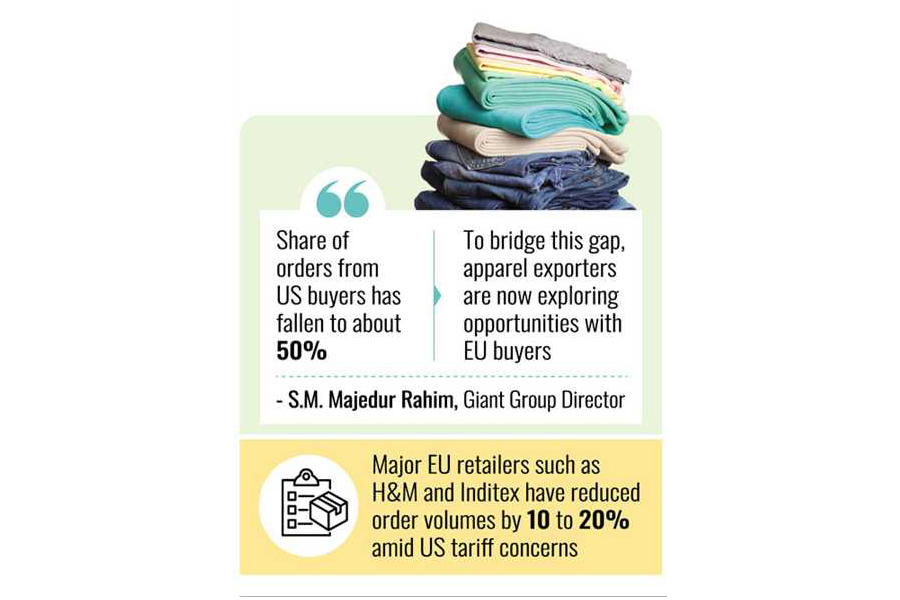US tariff hike begins to bite before time
Apparel exporters feel pricing pressure from European buyers
Most US buyers pause in placing new orders amid tariff uncertainty

Published :
Updated :

Bangladeshi apparel exporters are getting under fresh pricing pressure from European buyers under shadows of a predeclared steep US tariff hike as they increasingly shift focus to the European Union in quest of new orders to fill production gaps, industry-insiders say.
Most US buyers are refraining from placing new orders due to the uncertainty surrounding the potential tariff rises, prompting manufacturers to turn more actively to the EU market.
Industry people have said European buyers are taking advantage of the situation, attempting to lower product prices as thousands of Bangladeshi exporters approach them in a scramble for orders.
"The share of orders from US buyers has fallen to about 50 per cent. To bridge this gap, apparel exporters are now exploring opportunities with EU buyers," says S.M. Majedur Rahim, Director at Giant Group.
"Even when US buyers are placing orders, the volumes are small. Some have already offered lower prices for repeat orders, citing tariff pressure. It's unfair to expect exporters to bear the cost of tariffs," he adds.
Major EU retailers such as H&M and Inditex -- who also have significant business in the US -- have reportedly reduced their order volumes by 10 to 20 per cent out of fears surrounding the oncoming US tariffs.
"There's growing uncertainty among buyers with exposure to the US market regarding the outcome of ongoing tariff negotiations. A 35-percent reciprocal tariff on Bangladeshi exports to the US is set to take effect from 1 August," says Majedur Rahim.
"European buyers are viewing this as an opportunity to renegotiate and reduce apparel prices -- even some have already done so," he further notes.
According to data from the National Board of Revenue (NBR), 2,377 Bangladeshi firms exported to the US in FY25. Of these, 801 depend on the US for more than 50 per cent of their total exports, making them particularly vulnerable.
Collectively, these companies exported $6.62 billion worth of goods globally in the last fiscal year (FY2024-25), of which $5.05 billion -- or 58 per cent of Bangladesh's total exports -- were to the US. Bangladesh exports nearly $10 billion worth of goods to the United States annually, including apparel, leather, plastic, and agro-products.
EU buyers trying to capitalise on tariff pressure: "One of my buyers from the Netherlands, who used to purchase garments at $3 per unit, has now offered a price that is 25-30-cent lower per unit, citing Trump-era tariff policies," said Fazlee Shamim Ehsan, CEO of Fatullah Apparels.
"I couldn't accept the order at that price. The total value of the order was \$750,000. Losing the deal has made it difficult to keep the factory running," he added.
The United States is the single-largest export destination for Bangladeshi garments. However, exporters had earlier warned that the impact of US tariff hikes could spill over into Europe -- the largest trade bloc.
"Due to the new US tariff policy, inflation has already risen on that market, and buyers have started reducing their apparel orders," Ehsan observed.
He further noted, "The ripple effects of the new US tariffs have begun to influence European buyers as well. Some of them are now offering lower prices than before."
When US-bound RMG exports suffer, it will impact other markets as well, since buyers often source from one country for multiple destinations, says Shovon Islam, Managing Director of Sparrow Group, adding: "The consequences will cascade."
Echoing Shovon's concerns, the country manager of a European apparel brand, speaking on condition of anonymity, said, "If the tariff issue is not resolved in Bangladesh's favour, it could reduce our business opportunities here."
He further stated, "Although the US market accounts for less than 10 per cent of our total sales, it would no longer be a viable business case for us to produce goods for them from Bangladesh. We may have to consider alternative sourcing options."
Traditionally, he added, it takes at least three years to develop a vendor.
The head of business development at PDS Group-the largest multinational buying house in Bangladesh-also speaking on condition of anonymity, said, "Some of our EU customers are now asking for price reductions on new orders."
He added that EU buyers are taking advantage of the situation, being aware of the global market scenario and the installed capacity of the Bangladeshi apparel industry.
Officials at the buying house further noted that orders from some promising non-traditional markets -- such as India and South Korea -- are also shrinking. This is due to factors that include non-tariff barriers in India and local political as well as global economic challenges in South Korea.
Exporters also fear tariff impact could hurt market competitiveness.
President of BGMEA Mahmud Hasan Khan Babu says that if an additional 35-percent tariff is imposed, US buyers are likely to shift to alternative sourcing destinations unless Bangladeshi exporters agree to offer discounts.
However, entrepreneurs argue that offering a 35-percent discount would make it extremely difficult to sustain business operations.
The BGMEA President further states, "If Bangladesh faces higher tariff rates than countries like Vietnam, India, and Pakistan, it will not bode well for our export sector."
The main concern for Bangladeshi apparel exporters is that rival countries such as Vietnam, Indonesia, India and Pakistan enjoy significantly lower tariff rates on the US market.
As a result, Bangladesh risks losing work orders to these competitors, potentially putting millions of jobs at risk and raising fears of labour unrest in the sector.
Currently, Bangladesh exports to the US at an average tariff rate of 15.5 per cent. If the proposed 35-percent reciprocal tariff is finally imposed, the total tariff burden would rise to an uphill 50.5 per cent.
newsmanjasi@gmail.com


 For all latest news, follow The Financial Express Google News channel.
For all latest news, follow The Financial Express Google News channel.